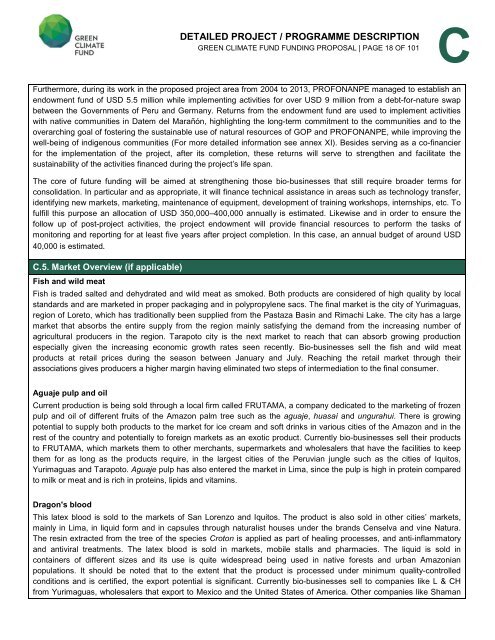proposals – Addendum
bf35cb34-05cf-4f96-a8fb-0adfa54cc3c9
bf35cb34-05cf-4f96-a8fb-0adfa54cc3c9
Create successful ePaper yourself
Turn your PDF publications into a flip-book with our unique Google optimized e-Paper software.
DETAILED PROJECT / PROGRAMME DESCRIPTION<br />
GREEN CLIMATE FUND FUNDING PROPOSAL | PAGE 18 OF 101<br />
C<br />
Furthermore, during its work in the proposed project area from 2004 to 2013, PROFONANPE managed to establish an<br />
endowment fund of USD 5.5 million while implementing activities for over USD 9 million from a debt-for-nature swap<br />
between the Governments of Peru and Germany. Returns from the endowment fund are used to implement activities<br />
with native communities in Datem del Marañón, highlighting the long-term commitment to the communities and to the<br />
overarching goal of fostering the sustainable use of natural resources of GOP and PROFONANPE, while improving the<br />
well-being of indigenous communities (For more detailed information see annex XI). Besides serving as a co-financier<br />
for the implementation of the project, after its completion, these returns will serve to strengthen and facilitate the<br />
sustainability of the activities financed during the project’s life span.<br />
The core of future funding will be aimed at strengthening those bio-businesses that still require broader terms for<br />
consolidation. In particular and as appropriate, it will finance technical assistance in areas such as technology transfer,<br />
identifying new markets, marketing, maintenance of equipment, development of training workshops, internships, etc. To<br />
fulfill this purpose an allocation of USD 350,000<strong>–</strong>400,000 annually is estimated. Likewise and in order to ensure the<br />
follow up of post-project activities, the project endowment will provide financial resources to perform the tasks of<br />
monitoring and reporting for at least five years after project completion. In this case, an annual budget of around USD<br />
40,000 is estimated.<br />
C.5. Market Overview (if applicable)<br />
Fish and wild meat<br />
Fish is traded salted and dehydrated and wild meat as smoked. Both products are considered of high quality by local<br />
standards and are marketed in proper packaging and in polypropylene sacs. The final market is the city of Yurimaguas,<br />
region of Loreto, which has traditionally been supplied from the Pastaza Basin and Rimachi Lake. The city has a large<br />
market that absorbs the entire supply from the region mainly satisfying the demand from the increasing number of<br />
agricultural producers in the region. Tarapoto city is the next market to reach that can absorb growing production<br />
especially given the increasing economic growth rates seen recently. Bio-businesses sell the fish and wild meat<br />
products at retail prices during the season between January and July. Reaching the retail market through their<br />
associations gives producers a higher margin having eliminated two steps of intermediation to the final consumer.<br />
Aguaje pulp and oil<br />
Current production is being sold through a local firm called FRUTAMA, a company dedicated to the marketing of frozen<br />
pulp and oil of different fruits of the Amazon palm tree such as the aguaje, huasaí and ungurahui. There is growing<br />
potential to supply both products to the market for ice cream and soft drinks in various cities of the Amazon and in the<br />
rest of the country and potentially to foreign markets as an exotic product. Currently bio-businesses sell their products<br />
to FRUTAMA, which markets them to other merchants, supermarkets and wholesalers that have the facilities to keep<br />
them for as long as the products require, in the largest cities of the Peruvian jungle such as the cities of Iquitos,<br />
Yurimaguas and Tarapoto. Aguaje pulp has also entered the market in Lima, since the pulp is high in protein compared<br />
to milk or meat and is rich in proteins, lipids and vitamins.<br />
Dragon's blood<br />
This latex blood is sold to the markets of San Lorenzo and Iquitos. The product is also sold in other cities’ markets,<br />
mainly in Lima, in liquid form and in capsules through naturalist houses under the brands Censelva and vine Natura.<br />
The resin extracted from the tree of the species Croton is applied as part of healing processes, and anti-inflammatory<br />
and antiviral treatments. The latex blood is sold in markets, mobile stalls and pharmacies. The liquid is sold in<br />
containers of different sizes and its use is quite widespread being used in native forests and urban Amazonian<br />
populations. It should be noted that to the extent that the product is processed under minimum quality-controlled<br />
conditions and is certified, the export potential is significant. Currently bio-businesses sell to companies like L & CH<br />
from Yurimaguas, wholesalers that export to Mexico and the United States of America. Other companies like Shaman


